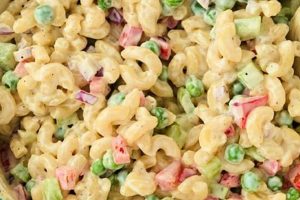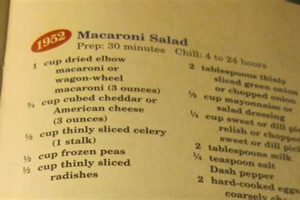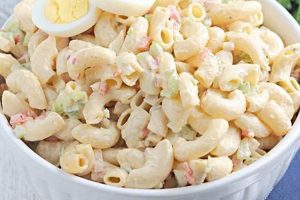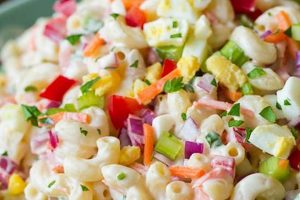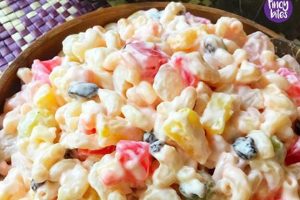A top-tier macaroni salad balances creamy richness with textural complexity. It typically features cooked elbow macaroni, a mayonnaise-based dressing, and a variety of complementary ingredients like celery, onion, and sweet pickles. Exceptional versions often incorporate nuanced flavors from mustard, paprika, or vinegar, and might include hard-boiled eggs, shredded carrots, or other vegetables for added depth.
This classic dish is a staple at picnics, potlucks, and barbecues, offering a refreshing and satisfying side that pairs well with grilled meats, sandwiches, and other summer fare. Its enduring popularity stems from its versatility, affordability, and make-ahead convenience. Variations abound, allowing for customization based on personal preferences and dietary needs, ranging from traditional recipes to healthier alternatives using Greek yogurt or lighter dressings.
The following sections will delve into the essential components of a superior macaroni salad, exploring ingredient selection, dressing variations, and tips for achieving optimal texture and flavor. Guidance on storage and serving suggestions will also be provided.
Tips for an Exceptional Macaroni Salad
Achieving a truly delicious macaroni salad involves careful attention to detail throughout the preparation process. These tips offer guidance on optimizing flavor, texture, and overall quality.
Tip 1: Cook the pasta al dente. Slightly firm pasta holds its shape better and prevents a mushy salad. Drain the pasta immediately and rinse under cold water to stop the cooking process.
Tip 2: Employ high-quality mayonnaise. The foundation of the dressing significantly impacts the final flavor. Experiment with different brands to find a preferred taste and texture.
Tip 3: Balance sweetness and acidity. Sweet pickles, relish, or a touch of sugar provide sweetness, while vinegar or lemon juice add necessary acidity. Achieving the right balance is key.
Tip 4: Incorporate textural variety. Finely diced celery and onions provide satisfying crunch, while hard-boiled eggs or shredded carrots introduce additional texture and protein.
Tip 5: Season thoughtfully. Salt, pepper, paprika, mustard powder, and other seasonings enhance the overall flavor profile. Adjust seasonings to taste.
Tip 6: Chill thoroughly. Allowing the salad to chill for at least two hours, or preferably overnight, allows the flavors to meld and develop fully.
Tip 7: Garnish strategically. Fresh herbs like parsley or chives, a sprinkle of paprika, or a few reserved hard-boiled egg slices elevate the presentation.
By following these tips, one can create a macaroni salad that is both visually appealing and exceptionally flavorful. A well-balanced combination of ingredients and proper chilling time are essential for optimal enjoyment.
In conclusion, crafting a superlative macaroni salad is attainable with attention to these key considerations.
1. High-Quality Ingredients
Ingredient quality directly impacts the overall flavor and texture of macaroni salad. Utilizing premium mayonnaise creates a rich, creamy base, while fresh, crisp vegetables contribute textural complexity and vibrant flavor. For instance, opting for flavorful, firm tomatoes as opposed to bland, mealy ones significantly elevates the salad’s taste profile. Similarly, freshly chopped herbs offer a brighter, more pronounced flavor compared to dried alternatives. The difference between sharp cheddar cheese and a generic processed cheese is substantial, impacting both the flavor and the visual appeal of the final dish. Employing high-quality ingredients ensures a superior culinary experience.
Substandard ingredients can detract from the final product. Limp celery, wilted onions, or overly processed cheese can result in a less appealing and flavorful salad. Furthermore, using low-quality mayonnaise can create a greasy, unappetizing texture. The overall taste experience suffers when ingredients lack freshness and vibrancy. Investing in superior components, however, allows individual flavors to shine, contributing to a more satisfying and enjoyable culinary result.
Prioritizing high-quality ingredients is a crucial step in creating exceptional macaroni salad. It showcases an attention to detail and a commitment to delivering the best possible flavor and texture. This principle extends beyond macaroni salad to virtually any culinary endeavor, demonstrating the significant impact of ingredient selection on overall quality. The investment in premium components elevates the dish from ordinary to extraordinary, justifying the slight increase in cost and effort.
2. Balanced Flavor Profile
A balanced flavor profile is paramount in achieving a superlative creamy macaroni salad. The interplay of creamy, tangy, sweet, and savory elements distinguishes a truly exceptional salad from a mediocre one. Understanding the key flavor components and their interactions is essential for crafting a well-rounded and satisfying dish.
- Creaminess
The foundation of any creamy macaroni salad lies in its rich, smooth texture. High-quality mayonnaise provides the primary source of creaminess, creating a luscious coating for the pasta and other ingredients. The level of creaminess can be adjusted by incorporating ingredients like sour cream or Greek yogurt, offering a lighter alternative while maintaining a desirable texture.
- Tanginess
Tanginess provides a necessary counterpoint to the richness of the mayonnaise, preventing the salad from becoming overly heavy. Ingredients like vinegar, lemon juice, or dill pickle relish introduce a refreshing acidity that brightens the overall flavor profile. The level of tanginess should be carefully calibrated to complement, not overpower, the other flavors.
- Sweetness
A touch of sweetness adds depth and complexity to the flavor profile. Sweet pickle relish, finely diced sweet onions, or a small amount of sugar can contribute this element. The sweetness should be subtle, enhancing the other flavors rather than dominating them. Overly sweet macaroni salad can quickly become cloying.
- Savory Notes
Savory elements provide balance and depth. Ingredients like celery, hard-boiled eggs, mustard, or a pinch of celery seed contribute savory notes that complement the creamy, tangy, and sweet elements. These savory notes are crucial for preventing the salad from tasting one-dimensional.
A truly exceptional creamy macaroni salad masterfully balances these four key flavor components. The creamy richness of the mayonnaise is tempered by the bright tanginess of vinegar or relish, while a hint of sweetness adds depth. Savory notes from vegetables and seasonings complete the flavor profile, creating a harmonious and satisfying culinary experience. Careful consideration of these elements is crucial for achieving a well-rounded and delicious final product.
3. Optimal Pasta Texture
Optimal pasta texture is crucial for a superlative creamy macaroni salad. “Al dente” pasta, cooked until firm to the bite, provides the ideal foundation. Overcooked pasta becomes mushy and absorbs too much dressing, resulting in a heavy, unappetizing salad. Undercooked pasta, conversely, offers an unpleasant, firm texture that detracts from the overall experience. The perfect texture provides a pleasant chewiness that complements the creamy dressing without becoming soggy. This balance is essential for a successful macaroni salad.
Consider two scenarios: one with perfectly cooked al dente pasta and another with overcooked pasta. In the first, each bite offers a pleasant resistance, the pasta holding its shape while coated in the creamy dressing. The individual pieces remain distinct, contributing to a satisfying textural experience. In the second scenario, the overcooked pasta has become a soft, mushy mass, absorbing an excessive amount of dressing. The salad lacks textural definition and becomes heavy and less appealing. This stark contrast illustrates the significant impact of proper pasta texture on the final product.
Achieving al dente pasta requires careful attention to cooking time and proper draining. Following package instructions is a good starting point, but adjustments may be necessary depending on the specific pasta and cooking method. Testing the pasta frequently during cooking ensures optimal doneness. Immediately draining the cooked pasta and rinsing it under cold water stops the cooking process and helps maintain the desired firmness. This meticulous approach is key to achieving a creamy macaroni salad with a delightful texture, contributing significantly to the overall enjoyment of the dish.
4. Proper Chilling Time
Proper chilling time is integral to a superlative creamy macaroni salad. Chilling allows the flavors to meld and deepen, transforming individual components into a cohesive, flavorful whole. This crucial step elevates the salad beyond a simple mixture of ingredients, creating a more complex and satisfying culinary experience. Insufficient chilling results in a less developed flavor profile, while excessive chilling can negatively impact the texture of certain ingredients.
- Flavor Development
Chilling allows the diverse flavors within the salad to harmonize. The tanginess of the vinegar, the sweetness of the relish, the richness of the mayonnaise, and the savory notes of the vegetables all meld together, creating a more nuanced and balanced flavor profile. This fusion of flavors is essential for a truly exceptional macaroni salad. A freshly made salad, while palatable, lacks the depth of flavor achieved through proper chilling.
- Texture Enhancement
Chilling firms the pasta and other ingredients, enhancing the overall texture of the salad. The cold temperature also improves the creaminess of the dressing, making it more cohesive and less likely to separate. This textural improvement contributes significantly to the enjoyment of the dish. A warm macaroni salad often feels heavy and less refreshing, while a properly chilled salad offers a more pleasant, crisp texture.
- Optimal Chilling Duration
The ideal chilling time for macaroni salad is typically between two and four hours. This duration allows sufficient time for flavor development and textural enhancement without compromising the quality of the ingredients. Chilling overnight is also acceptable, but it’s important to note that certain vegetables, like cucumbers, may become slightly softer over extended periods. Careful consideration of chilling time ensures optimal flavor and texture.
- Temperature Considerations
Maintaining a consistent, cool temperature throughout the chilling process is essential. Fluctuations in temperature can negatively affect the texture of the salad, potentially causing the dressing to separate or the vegetables to become soggy. Storing the salad in an airtight container in the refrigerator helps maintain a stable temperature and prevents the absorption of unwanted odors from other foods.
Proper chilling is not merely a final step; it is a crucial element in crafting an exceptional creamy macaroni salad. The transformative effect of chilling on flavor and texture elevates the dish from a simple combination of ingredients to a harmonious and delightful culinary creation. Attention to chilling time, along with careful consideration of temperature consistency, ensures the optimal enjoyment of this classic dish.
5. Creative Ingredient Combinations
Creative ingredient combinations elevate a standard creamy macaroni salad recipe to new heights. While traditional ingredients provide a familiar base, thoughtful additions introduce complexity and intrigue, resulting in a more memorable culinary experience. The interplay of textures, flavors, and colors creates a dynamic and satisfying dish that moves beyond the ordinary. This exploration delves into the impact of innovative ingredient combinations on macaroni salad, highlighting their importance in achieving a truly exceptional result.
Consider the standard components: macaroni, mayonnaise, celery, and onion. While palatable, this combination can lack depth. Introducing roasted red peppers adds a smoky sweetness and vibrant color. Incorporating crumbled bacon contributes a salty, smoky crunch. Chopped fresh dill introduces a bright, herbaceous note. These additions, while seemingly simple, transform the flavor profile and textural experience. The combination of creamy, crunchy, sweet, smoky, and herbaceous notes creates a symphony of flavors that engage the palate. Such creative additions demonstrate that even minor alterations can yield significant improvements.
Further exploration reveals the potential of non-traditional ingredients. Blanched and chopped broccoli florets offer a nutritional boost and a contrasting texture. Toasted slivered almonds introduce a nutty crunch and healthy fats. Crumbled feta cheese provides a salty, tangy counterpoint to the creamy dressing. Even the type of pasta can be reconsidered. Small shells capture the dressing effectively, while rotini adds visual interest. These examples illustrate how imaginative ingredient combinations can revitalize a classic dish. The key lies in understanding flavor profiles and textural contrasts to create a harmonious and delicious result. Experimentation is encouraged; the possibilities are vast.
Frequently Asked Questions
This section addresses common inquiries regarding the preparation and enjoyment of exceptional creamy macaroni salad.
Question 1: What type of pasta is best suited for macaroni salad?
Elbow macaroni is the traditional choice, but other small pasta shapes like shells, ditalini, or rotini work well. The key is to choose a pasta that holds its shape and effectively captures the dressing.
Question 2: How can one prevent macaroni salad from becoming watery?
Ensure the pasta is cooked al dente and drained thoroughly. Dress the salad shortly before serving, and avoid over-mixing, which can release excess starch and create a watery consistency.
Question 3: Can macaroni salad be made ahead of time?
Macaroni salad benefits from chilling, allowing flavors to meld. Prepare it up to two days in advance and store it in an airtight container in the refrigerator. Add delicate ingredients like fresh herbs just before serving.
Question 4: What are some healthier alternatives to traditional macaroni salad ingredients?
Greek yogurt can replace some or all of the mayonnaise for a lighter dressing. Reduce the amount of sugar or use a sugar substitute. Incorporate additional vegetables like chopped bell peppers or shredded carrots for added nutrients.
Question 5: How long can macaroni salad be stored in the refrigerator?
Properly stored in an airtight container, macaroni salad typically lasts for three to five days in the refrigerator. Always check for spoilage before consuming.
Question 6: Can frozen vegetables be used in macaroni salad?
Fresh vegetables are generally preferred for optimal texture and flavor. If using frozen vegetables, ensure they are fully thawed and drained before incorporating them into the salad to avoid excess moisture.
Understanding these common points of inquiry can assist in achieving a superior macaroni salad experience. Proper preparation techniques and ingredient selection are crucial for maximizing flavor, texture, and overall enjoyment.
The next section offers a collection of recommended recipes, incorporating the principles and techniques discussed throughout this guide.
A Superior Creamy Macaroni Salad
Exploration of optimal creamy macaroni salad preparation reveals the significance of ingredient quality, balanced flavor profiles, proper pasta texture, adequate chilling time, and creative ingredient combinations. High-quality mayonnaise and fresh produce form the foundation. Balancing creamy, tangy, sweet, and savory notes ensures a well-rounded flavor profile. Al dente pasta contributes ideal texture, while chilling allows flavors to meld. Creative ingredient additions elevate the dish beyond the ordinary. Attention to these details transforms a simple side dish into a culinary highlight.
Culinary success hinges on a comprehensive understanding of these key elements. Application of these principles elevates not only macaroni salad but also broader culinary endeavors. The pursuit of exceptional flavor and texture requires continuous learning and experimentation. This exploration provides a framework for achieving excellence in creamy macaroni salad preparation and encourages further culinary exploration.

